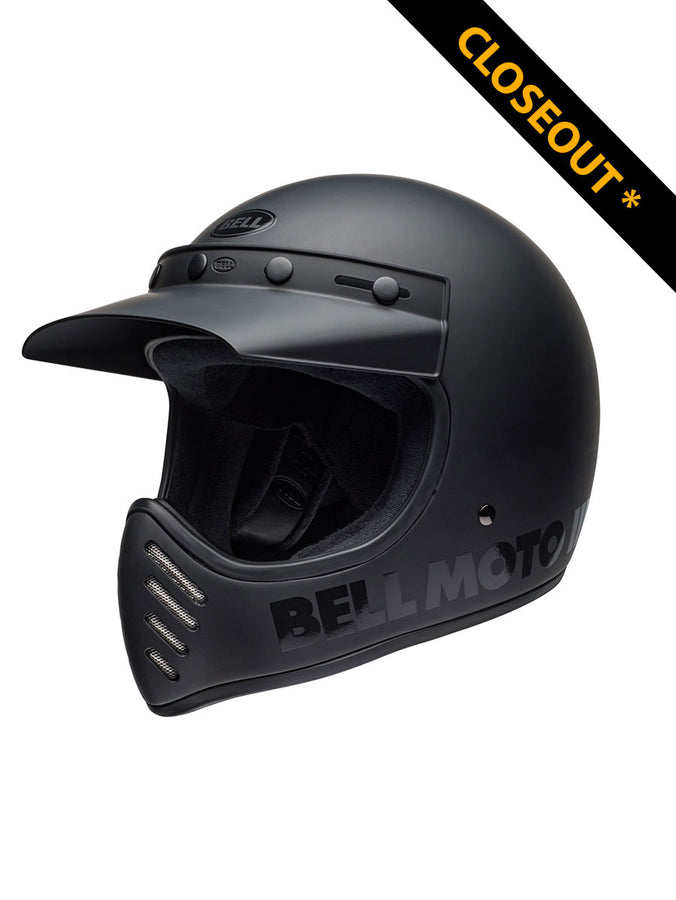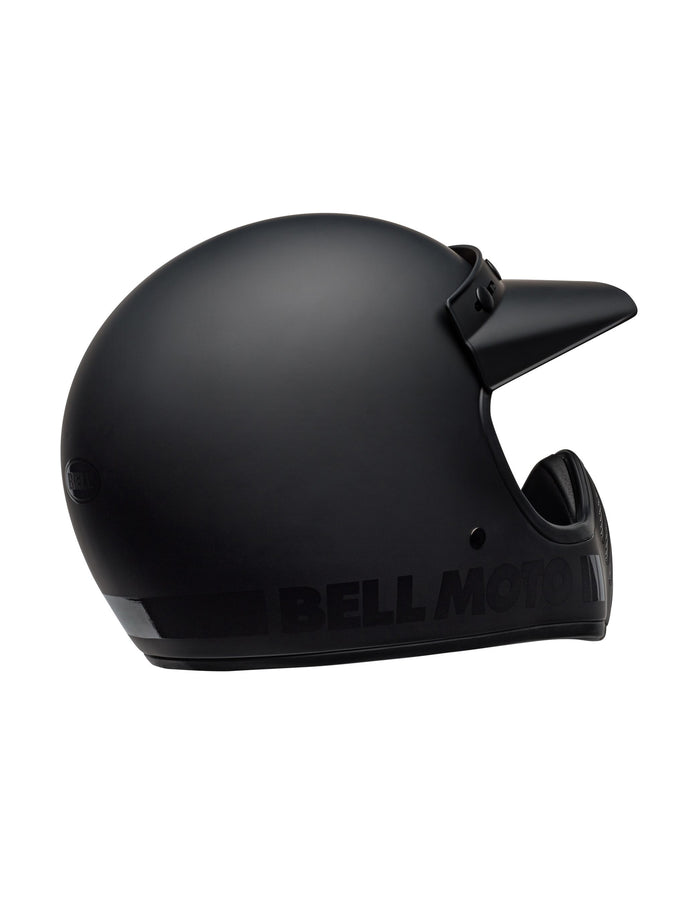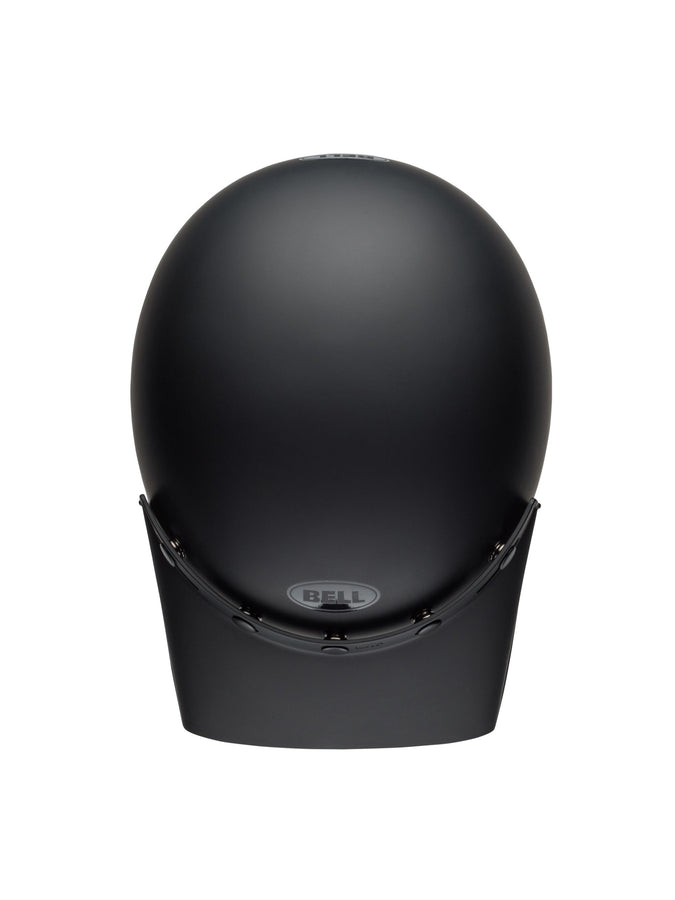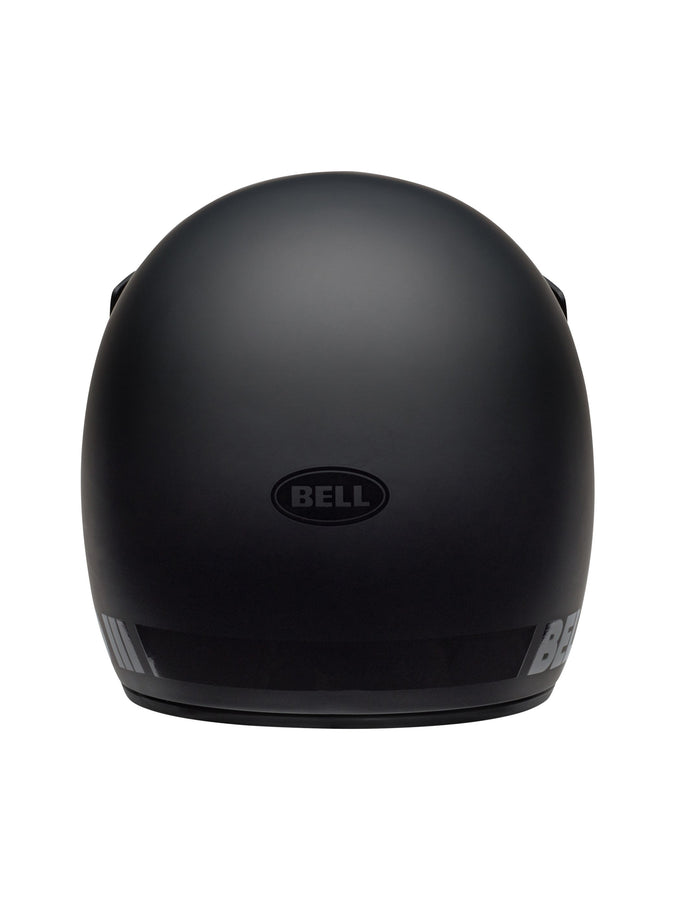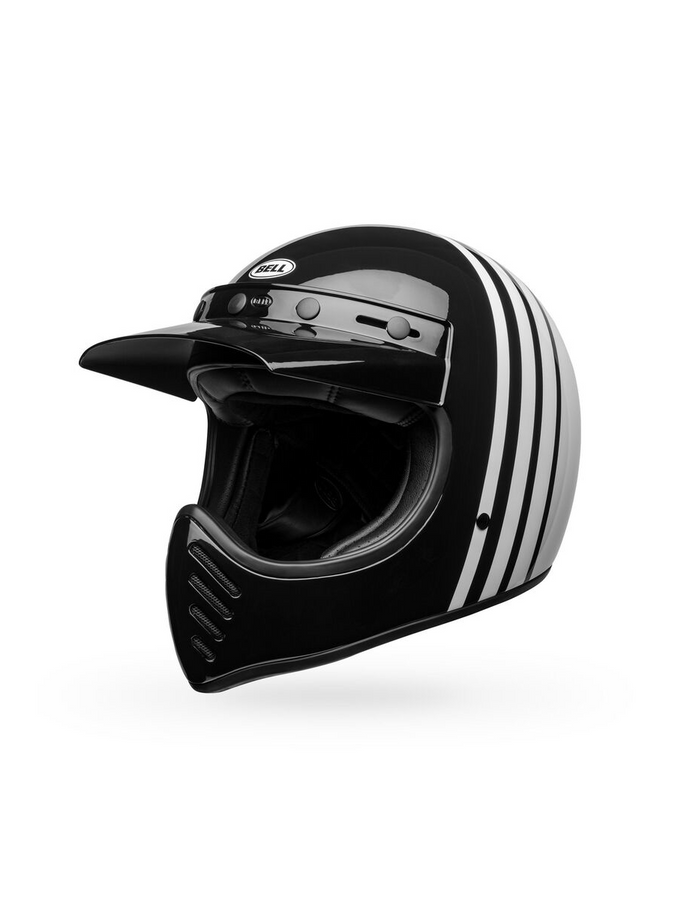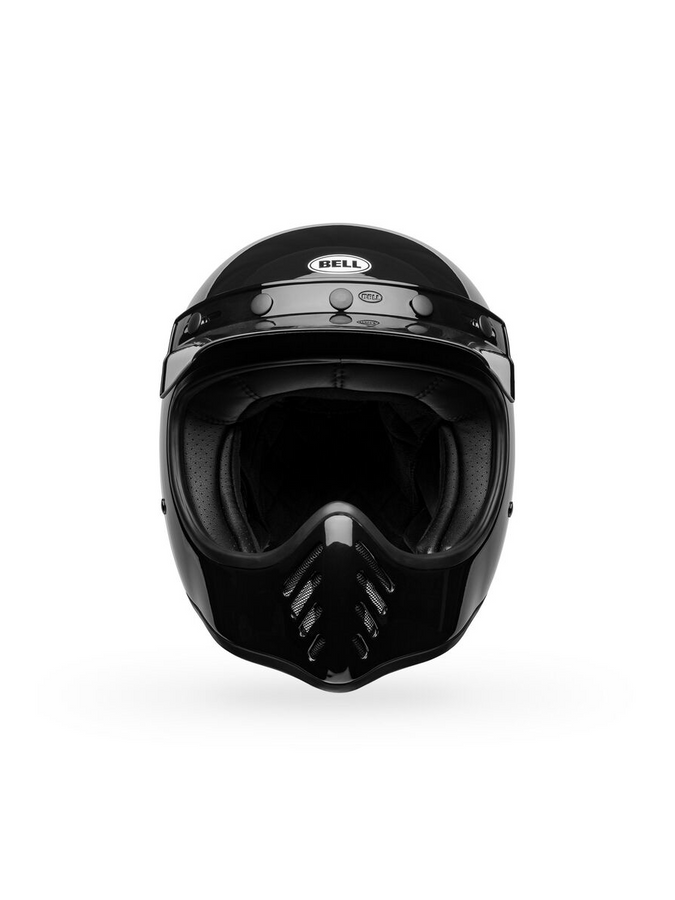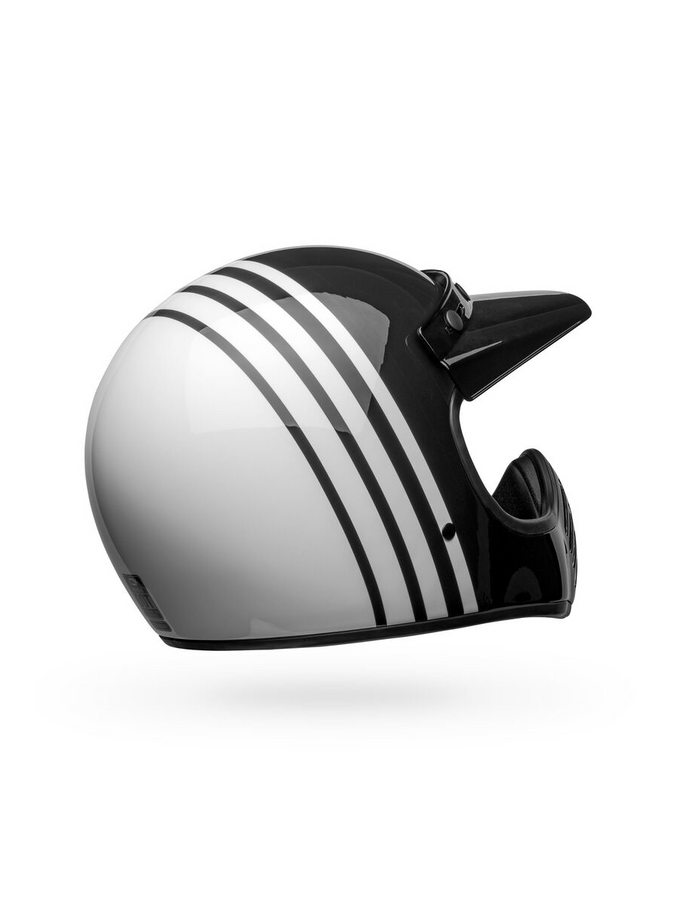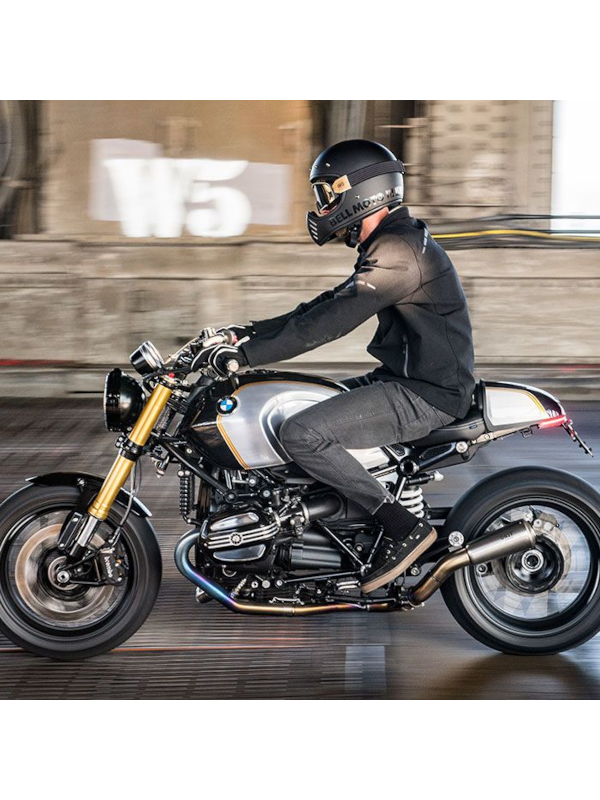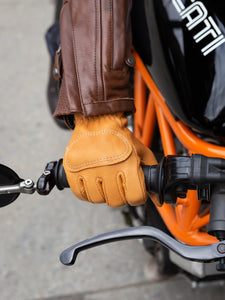As one of the most widely produced early full-face dirt bike helmets the original Moto 3 was taken up by legions of riders during the halcyon days of 70s and 80s motocross racing. Its striking silhouette, simple lines and distinctive overall design minted it as an instant classic.
Meet the “new” Moto 3—a wholly improved version of the original that stays true to its ancestor’s aesthetics. Made from a lightweight fiberglass composite shell, the Moto 3 comes in three shell sizes and four EPS sizes. What does that mean? See the size chart link for a visual aid, but basically XS, S and M-sized helmets share one shell, L and XL share another, but get individualized liners, and XXL gets a shell and liner of its own.
And although the Moto 3’s sold in the U.S. are marked DOT only, they’re the same exact EPS and fiberglass layup as the ECE-certified Moto 3’s sold in Europe. So while that fact won’t get you out of a ticket with a French cop, rest assured you’re head is covered with two very solid safety ratings.
So who is this helmet for? Anyone looking for a well ventilated, good looking, and reasonably safe full face helmet. Sure, you’re forgoing some nice modern street-helmet amenities: a shield to keep rain and bugs out (let alone a transitions or pinlock anti-fog visor); or a chin curtain for keeping out the cold. So you’ll need goggles or DOT riding glasses to be safe, and a neck gaiter for cold weather riding.
But for actual dirt bike use, or warm-weather dirt-road scrambling or urban commuting, the Moto 3 is a great choice. While it doesn’t offer the same amazing FLEX technology as Bell’s top-tier Moto 9 Flex, it’s on par with other dirt bike helmets in terms of protection.
What it does offer is a mega-wide field of view, light weight, and if you’re into the retro look, it’s a hell of a lot safer and more advisable than an open-face helmet.
- Original Bell Moto 3 styling
- DOT Certified in Fact
- ECE Certified in Spirit (US models not marked ECE)
- Lightweight Fiberglass composite shell
- 3 Shell and 4 EPS Sizes (See Size Chart)
- EPS lined chinbar
- Removable/Washable anti-microbial terrycloth liner
- 5-Snap Visor Included
As time and technology marched on, dirt bike helmet designs became more sculpted, lighter weight, better vented, safer—but they all still took design cues from the original Moto 3, which is no less than the primordial grandpappy of all dirt bike helmets to come after it. The original Moto 3 helmets were so widely produced they still exist in a netherworld of eBay auctions and estate sales, sometimes ‘new in box!’. And that’s fine and good as long as the helmets are used to decorate shelves, not protect one’s head from ejecting from a motorcycling at speed and expecting to see the other side of a guard rail.
PUBLIC SERVICE ANNOUNCEMENT: The life-saving EPS liner of any helmet expires after no more than 5 years. After that time, its crash-absorbing characteristics simply expire from exposure to the ambient environment, and from your sweaty head. Paint and cloth interiors can be replaced, but the EPS liner cannot.
As one of the most widely produced early full-face dirt bike helmets the original Moto 3 was taken up by legions of riders during the halcyon days of 70s and 80s motocross racing. Its striking silhouette, simple lines and distinctive overall design minted it as an instant classic.
Meet the “new” Moto 3—a wholly improved version of the original that stays true to its ancestor’s aesthetics. Made from a lightweight fiberglass composite shell, the Moto 3 comes in three shell sizes and four EPS sizes. What does that mean? See the size chart link for a visual aid, but basically XS, S and M-sized helmets share one shell, L and XL share another, but get individualized liners, and XXL gets a shell and liner of its own.
And although the Moto 3’s sold in the U.S. are marked DOT only, they’re the same exact EPS and fiberglass layup as the ECE-certified Moto 3’s sold in Europe. So while that fact won’t get you out of a ticket with a French cop, rest assured you’re head is covered with two very solid safety ratings.
So who is this helmet for? Anyone looking for a well ventilated, good looking, and reasonably safe full face helmet. Sure, you’re forgoing some nice modern street-helmet amenities: a shield to keep rain and bugs out (let alone a transitions or pinlock anti-fog visor); or a chin curtain for keeping out the cold. So you’ll need goggles or DOT riding glasses to be safe, and a neck gaiter for cold weather riding.
But for actual dirt bike use, or warm-weather dirt-road scrambling or urban commuting, the Moto 3 is a great choice. While it doesn’t offer the same amazing FLEX technology as Bell’s top-tier Moto 9 Flex, it’s on par with other dirt bike helmets in terms of protection.
What it does offer is a mega-wide field of view, light weight, and if you’re into the retro look, it’s a hell of a lot safer and more advisable than an open-face helmet.
- Original Bell Moto 3 styling
- DOT Certified in Fact
- ECE Certified in Spirit (US models not marked ECE)
- Lightweight Fiberglass composite shell
- 3 Shell and 4 EPS Sizes (See Size Chart)
- EPS lined chinbar
- Removable/Washable anti-microbial terrycloth liner
- 5-Snap Visor Included
As time and technology marched on, dirt bike helmet designs became more sculpted, lighter weight, better vented, safer—but they all still took design cues from the original Moto 3, which is no less than the primordial grandpappy of all dirt bike helmets to come after it. The original Moto 3 helmets were so widely produced they still exist in a netherworld of eBay auctions and estate sales, sometimes ‘new in box!’. And that’s fine and good as long as the helmets are used to decorate shelves, not protect one’s head from ejecting from a motorcycling at speed and expecting to see the other side of a guard rail.
PUBLIC SERVICE ANNOUNCEMENT: The life-saving EPS liner of any helmet expires after no more than 5 years. After that time, its crash-absorbing characteristics simply expire from exposure to the ambient environment, and from your sweaty head. Paint and cloth interiors can be replaced, but the EPS liner cannot.
